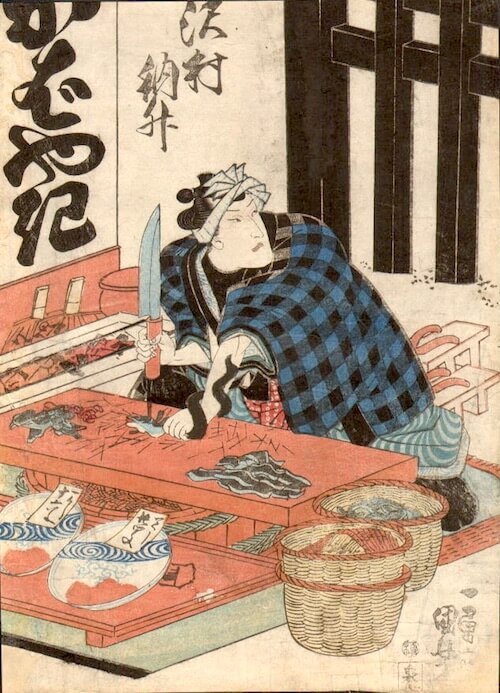Here we will explain exactly what Edomae (Edo-style) means.
In fact, the first type of restaurant “Edomae (Edo-style)” was applied to eel restaurants. Ieyasu Tokugawa was ordered to Edo (modern Tokyo) and put all of his efforts into developing the uninhabitable land into a city. He changed the flow of the rivers and built an island in a shallow part of the sea in front of Edo Castle. A large amount of eel was caught in the construction process, and one smart person upon seeing this, cut the eel up, skewed it and grilled it with miso to sell at great profit to laborers as their lunch. This was called Edomae (Edo-style) grilled eel (or more literally grilled eel in front of Edo).
 Around this time, the eel caught in front of Edo castle was known as “Edomae (or in front of Edo) and it was classified differently from the eel that took many days to transport from outlying regions, which was called “Traveling Eel” (tabi-unagi). Edomae carried a reputation of not only being delicious but also fresh.
Around this time, the eel caught in front of Edo castle was known as “Edomae (or in front of Edo) and it was classified differently from the eel that took many days to transport from outlying regions, which was called “Traveling Eel” (tabi-unagi). Edomae carried a reputation of not only being delicious but also fresh.
Gradually the designation of Edomae came to refer to any fish that came from the sea in front of Edo. And as the popularity of nigiri-sushi rose, the word “Edomae” came to be applied exclusively to nigiri-sushi. Until Yohei Hanaya made nigiri-sushi popular, what was being eaten in Edo was pressed “Oshi-zushi” that came from Osaka. Perhaps they applied the nomenclature “Edomae” to nigiri-sushi to distinguish it from the pressed sushi.
Also, before long “Edomae” became synonymous with “refined (iki)*” or “chic (inase)**” because the seafood caught in the sea in front of Edo was “lively with good form.” Then the term was used when holding ceremonies according to Edo customs, so it became a word that symbolized the character of Tokyoites. You can imagine people deliberately using the term “Edo-style/Edo-mae” to counter the prefix “Miyabi***”, which is used to refer to the noble court culture of Kyoto.
*Iki (粋) means something that is glamorous, noble, and refreshing.
** Inase (鯔背) means a bit of “iki” and assertive, used to compliment manliness.
***Miyabi (雅) means elegant and luxurious.
At that point in history, there was no refrigeration or ice and eating fish raw was not possible, so seafood would be treated in various ways so that it could be kept for a period of time, for example, treating it with salt and vinegar while it was fresh, boiling, or soaking it in soy sauce. As result sushi transformed, starting from a preservation method and morphing into a way of enjoying food that maximizes the umami of the ingredients. Later, these methods would come to be known collectively as “Edo-style work (edomae shigoto).”
Many people think that sushi made with this Edomae shigoto is Edomae sushi. However, with the development of refrigeration technology, it is no longer necessary to think about preservation as in the past. Therefore, Edomae shigoto which matches today’s needs has been created.
For example, if the fish is fresh and firm, the knife should be finely cut, and shiromi should not be Kobujime, but should be left to rest for half a day to one day before use. This will produce inosinic acid, which will make the fish tastier and also allow it to adhere to the shari. The toppings are also allowed to mature for a considerable period.
These current Edomae shigoto require that Ikejime and other processes be performed immediately after the fish is caught. On the other hand, items that are freshly caught, hard and not adhering to the shari are not considered Edomae sushi if they are nigiri as they are. Simply put, it is just vinegared rice (sushi rice) with sashimi on top. The idea that freshness is the most important aspect of fish is not in line with the concept of Edomae sushi.
When Nigiri sushi was first created, the toppings used were fish caught in Tokyo Bay, the sea in front of Edo (Tokyo, Japan). That is why it is often thought of as “Edomae sushi” because it uses fish from Edomae.
Nowadays, less seafood is caught in the Tokyo bay area in front of Edo, and the overwhelming majority comes from other regions and from overseas. By that definition, the term Edomae is being stripped of its substance in a way. However, nobody seems to mind what the original meaning of the word was, and nigiri-sushi is referred to as Edomae sushi all over Japan. The term Edomae sushi (Edo style sushi or Edo sushi) is understood everywhere from Hokkaido to Kyushu.
Edomae (Edo-style) has meant a lot of things through the years, but now it is a phrase that really represents the culture that Tokyo has given to the country and the world.
Related contents:
Why is Zuke used for lean meat?
Kohada (Gizzard shad) flavor is refined by exquisite salt seasoning!
Share this article